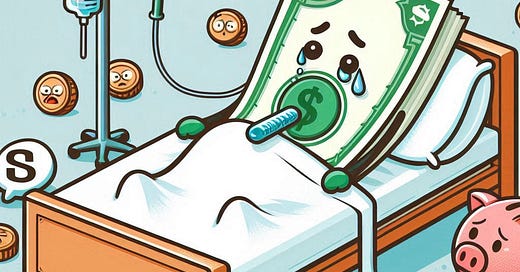Is the Dollar on Its Deathbed?
A former OMB director and Midwestern governor sounds the death knell.
“The Day the Dollar Died Is Coming,” writes Mitch Daniels, former director of the federal Office of Management and Budget and former governor of Indiana, in a Washington Post op-ed.
Daniels’ superb article draws attention to an upcoming national disaster: “the debt cataclysm that more and more observers are now calling probable or even unavoidable.” This catastrophe will be the result of massive overspending by the federal government throughout the twenty-first century.
The spending has been taken on as government debt, not paid for by current taxes—a process that has a limited lifespan. We are now reaching that threshold, Daniels notes, and the consequences will be unlike anything the United States has ever experienced—this for a nation that endured a horrific Civil War and a grueling Great Depression.
Daniels calls for national leaders and thinkers to launch a conference right away to prepare for this inevitability:
… a plan for the collapse of the U.S. public debt market and the dollar’s world reserve status—and the economic and social consequences of such an event. With debts already about to surpass the nation’s entire GDP, and adding close to $2 trillion more this year, only a dwindling number of denialists doubt that a cataclysmic reckoning, including double-digit damage to Americans’ income growth, lies ahead. It’s past time to prepare.
As Daniels notes, excessive government debt is not a trivial matter: it is a common means by which governments self-destruct, and once a nation enters a debt spiral it can be impossible to prevent a collapse not only of the government but of social order and moral standards. (That is why former president Donald Trump is right to refer to Venezuela as a benchmark.)
To a layperson not versed in the effects of government spending and finance, it may not seem obvious that “a little” more debt each year, in percentage terms, could be a problem. Market analyst Dylan Jovine does an excellent job of explaining that process in a post about Daniels’s op-ed: “The very first domino that’s going to fall is bond prices are going to plunge and interest rates will spike,” Jovine writes.
The decrease in bond prices ripples through the economy. With the dollar as the world’s reserve currency, businesses around the world buy U.S. government bonds to facilitate their trades with one another. A great reduction in the use of the dollar as a reserve currency would remove that incentive to buy U.S. government bonds, thus pushing up interest rates in the United States. Jovine writes,
Remember, bond prices and interest rates have a seesaw relationship.
If Mercedes-Benz is buying bonds, that helps push the price of bonds high, which keeps interest rates low [in the United States in this example—STK].
If countries and institutions and companies like Mercedes-Benz stop buying bonds because they don’t trust the dollar as the world’s reserve currency …
Those buyers will leave the market. The price of bonds will fall. Interest rates will jump.
The increase in interest rates slows economic activity in the United States by making money more expensive and thereby increasing the cost of transactions. Jovine writes,
When that happens, mortgage rates will rise and housing prices will fall. The stock market will crash. Retirement accounts will crash.
This is deadly serious business.
What makes his op-ed so unique is that he thinks beyond the fiscal ramifications to what this really looks like:
He talks about the societal upheavals that will come when that happens.
At that point, the president and Congress will have to decide “which government safety-net promises to renege on immediately, which previously sacred discretionary spending to eliminate, how to protect the nation with a shrunken defense budget and which new taxes to impose,” Daniels notes.
Obviously, the public will be horrified by those choices. The debt crisis will bring on a “sense of social betrayal” among the public (many or most of whom voted for the people who perpetrated the problems), and the “accompanying economic collapse could unleash violent reactions in a country that has become grimly familiar or even inured to such conduct,” Daniels writes.
Whoever is president at that time will be tempted to use some of “the president’s more than 100 unilateral emergency powers” and even declare martial law, which “has been invoked at least 68 times, but no act of Congress defines it,” Daniels writes.
What limits a president would place on him- or herself at that time are unclear, Daniels notes. I am not optimistic about that. Daniels writes,
What is and is not permitted by the language of the Insurrection Act, authorizing the use of the military not just to “suppress the rebellion” but also to suppress an “unlawful combination or conspiracy” that “hinders the execution of the laws”?
We have heard the word “insurrection” thrown around falsely for almost four years now. Widespread social unrest created by the debt crisis could bring a government backlash that would explicitly characterize the people as the enemy of the government, and more importantly, establish the (well-armed) government as the enemy of the people.
The loss of government authority and credibility at that point would be enormous. There would be little chance of a restoration of public order and any trust in government.
Daniels rightly argues that the nation’s leaders must begin to prepare for that eventuality as soon as possible, developing a catastrophe plan, as any sensible business owner or leader of an institution does. There are things that can be done to limit the damage of the upcoming debt crisis, Daniels notes. Though our leaders have shown no propensity for making hard choices thus far, having a plan is better than not having one.
Though not much better, unfortunately.




